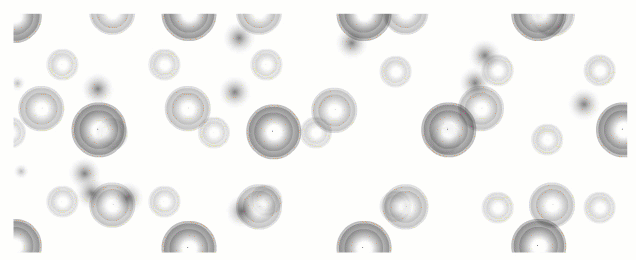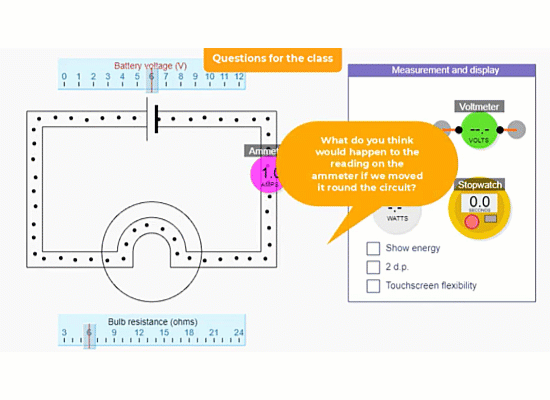
Simulations, animations and videos to teach electricity.
For teachers who care about physics.
A unique interactive circuit simulation for students of all abilities.
Mathematically self-consistent, with the correct physics built in, so you can make changes to a circuit, and see what happens to current, voltage and power.
Use in front of a class or as self-paced lessons.
Designed to flex to your individual teaching style. Incorporate Electricity Explained into your existing scheme of work, or let it do all the heavy lifting for you.
Use the simulations and animations in front of a class
3-min videos for homework, revision or flipped learning
Quizzes based on the animations in the lessons
Make invisible concepts easy to teach by visualising charge, current, potential difference and power.
Use the electric circuit simulation to visually teach all these topics and more
Teach with the simulation for FREE or power up with a paid plan
Free - Simple circuit simulation
Use the simple circuit simulation in front of a class to teach the core ideas of charge, current, potential difference and power. Supported by How-to videos, printable resources and online animated quizzes.
Teacher and Department - Add animations + more simulations
Whole-class teaching made simple. Dozens of unique animations plus series and parallel circuit simulations, enhanced with online quizzes and printable handouts, all organised into eighteen topics that make it simple to deliver memorable and engaging lessons that students will love.
Support your students with video lessons for homework, revision or flipped learning that they can access anywhere. Integrated into the whole-class Teacher/Department plan lesson sequence so you can be sure that the learning will stick.
School - Add video lessons for students
Trusted by physics teachers for more than 20 years
Furry Elephant is reborn
I wrote the original circuit animations using Flash when I was still teaching physics at Hampton School in 2001.
Since then, Furry Elephant has been through many incarnations, which finally came to an end when Flash was dropped by major browsers in 2020.
I had long-since moved away from physics teaching, but was amazed and humbled by the number of teachers contacting me from all over the world asking how they were going to teach electricity without Furry Elephant.
So I’ve rewritten the major simulations in JavaScript, and repurposed many of the most popular visualisations into gifs or videos, which is what you see today in this brand new incarnation - Electricity Explained.
It’s all about teaching and learning
Though the circuit simulation has been described as ‘the crown jewels’ by one physics teacher, my focus has never been about simply mimicing nature.
The circuit simulation is a means to an end - I’m trying to clarify the ideas that are difficult to teach and to be explicit about misconceptions - misconceptions that I certainly had when I was a beginning teacher under the great Jon Ogborn at London University Institute of Education.
For me, it’s not about going beyond the syllabus, but being crystal clear about the minimum knowledge you need to have a full understanding of the absolute foundations - for example that the charges are already there, and that they progress very slowly.
Crunchy physics in a soft coating
What physics teachers liked about Furry Elephant was that the physics was correct. Many physics teachers who are much cleverer and better qualified than I am still say they learned something from Furry Elephant.
It’s not about being abstruse or complex, it’s about having an insight into how to explain the most fundamental ideas in the simplest and most accessible way possible.
I’m quite clever, but I’m not very, very clever, and that means that I have to go on the same painful learning journey as most students and teachers.
As Jon Ogborn once said to me ‘I wouldn’t say I’m an expert, but I’ve thought about it very hard.’ I’ve thought about teaching electricity very hard over the past two decades - I think I understand it about 8.5/10. You can judge for yourself. Welcome to Electricity Explained.
Insights into teaching and learning electricity
Why the rope loop is a dangerously bad model for electric circuits
The IoP claims that the rope model has predictive powers - the problem is that in almost every case it predicts the exact opposite of how real circuits behave…more
Electrical ‘resistance’ is only a metaphor
The idea of electrical resistance is a horrible concept, and causes no end of confusion, though people are rarely aware that they’ve been confused. It’s one of the main…more
Battery voltage and the invisible 4th Law of electric circuits
When we have a simple circuit and we change the resistance, most teachers will simply say that you use the I=V/R relationship to calculate the new current…more
How batteries decide their chemical reaction rates
Batteries change the rate their chemical reactions run at depending on what they’re connected to - but how do they know what rate to that should be?…more
















